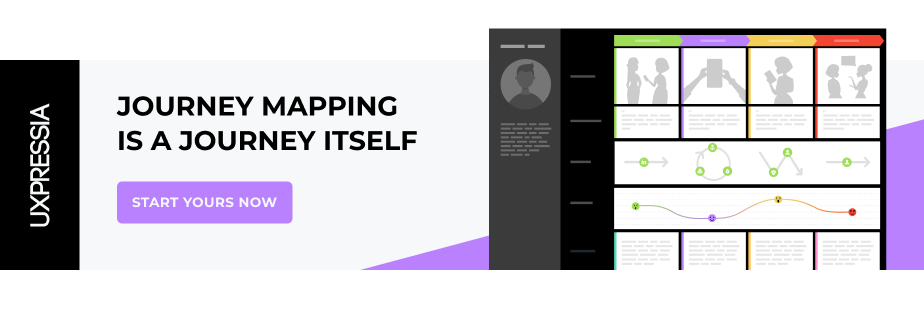This blog post focuses on the specifics of doing a journey mapping exercise in an asynchronous mode. It describes the advantages and disadvantages of such an approach, typical scenarios, challenges, and the ways to overcome them.
In the previous blog posts, we covered how to prepare the ground for launching a journey mapping project with a team and discussed collaborating on a mapping project in a synchronous mode. This time, we’ll look at another mode of collaboration: the asynchronous one.
Are you ready to learn more about collaborating async and how to make it work for your team? Then read on!
Contents
Doing a journey mapping exercise async: the advantages
Before proceeding to the pros of such collaboration, there’s one thing from our own experience for you to keep in mind:
| Working async doesn’t mean that you must fully exclude the synchronous work. At some point, you might want to do it, and it’s totally okay. We believe that the combination of these sync and async approaches works best. That’s why we encourage you to plan things ahead and think about which parts are better to do with your team together at the same time and which ones you can easily do in the async mode. |
So, when does it make sense to choose the async mode?
Sometimes simultaneous work is just not possible. For instance, it may happen because of your teammates’ busy schedules or when your team is in different time zones. The async mode gives you the flexibility to work together, but not at the same time.
It also may be the only way to include people who otherwise wouldn’t be able to participate at all.
Asynchronous collaboration: challenges and how to overcome them
When working asynchronously, you will inevitably face some of the following challenges:
- A longer feedback loop. When you work together in a virtual room or a physical office at the same time, it’s easy to clarify things on the go. You show what you did to others, get their feedback, make necessary changes — and here you go. With asynchronous collaboration, the feedback loop can take hours or days if not weeks, as you have to wait for everyone to check out the map, ask questions, add their findings, etc.
- Switching between contexts. Imagine your regular work day: daily routine, meetings, calls, emails that never ever end, urgent tasks that keep piling up… You are switching between different contexts all day long. And somewhere between all these things, you need time to think about some strategic things like a customer journey. It may be totally overwhelming.
- Different contexts. People involved in the journey mapping exercise are working on the same tasks while being in a different setting, their own world, and not in the same room. And being in different contexts, they might understand those tasks in very different ways.
Luckily, there are some things to do to overcome these challenges.
- Take context into account when you estimate the time you’re going to spend on the journey mapping exercise. Be sure to allocate proper time for the async collaboration, keeping in mind all possible time gaps:
- Enriching a finished map with some information might require half an hour. But if you haven’t seen the document for a while, you might need another hour (or even more) to delve into the context and get up to speed.
- You may also read the map in some chunks of time you have between meetings, have a question at some point, ask it, and wait for at least several hours to get the response.
- Help people orient themselves when they open the map. It’s certainly not easy to fully grasp the journey map when you see it for the first time. Especially if someone else already filled it in with lots of data. So it’s essential to make it as easy as possible to help others orient themselves on the map.
UXPressia tip #1: Explain things in a visual way
If you have multiple maps, you might want to make up some sort of hierarchy to let your team see the complete picture of what you have and where a specific map fits.
In UXPressia, we have the Design View functionality for that. It lets you get a quick view of the relation of the map with other maps and its place in the entire journey map ecosystem.
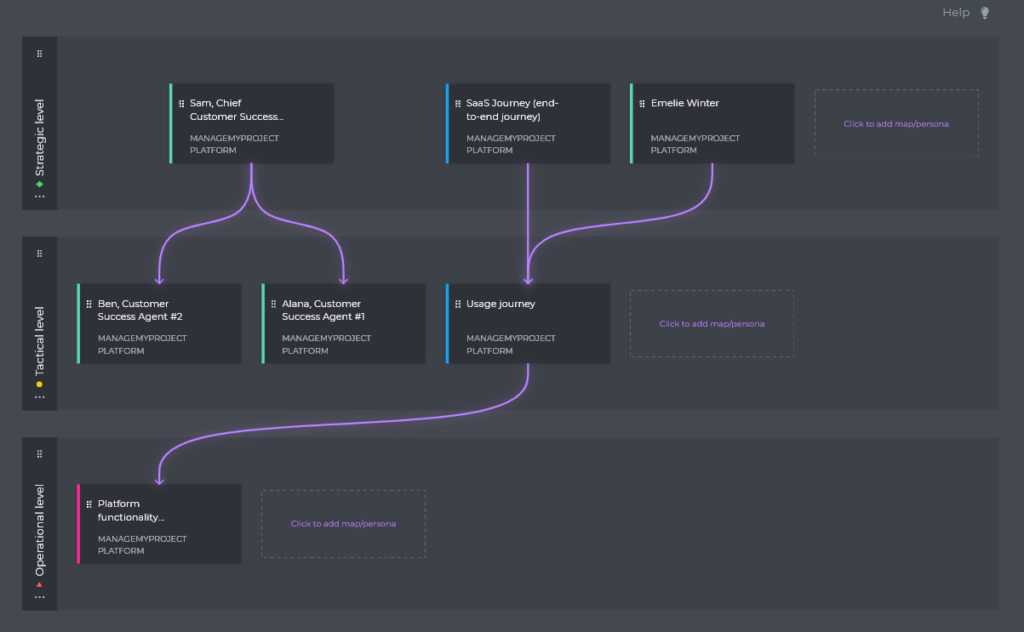
UXPressia tip #2: Add notes for your team
It is also helpful to have a short summary or a history of what’s been done so far and next steps that are expected from your team concerning the map. You can add all this information to the Map Description section. Imagine a person who returns to a map after several months of working on other projects: this summary should remind them what it’s all about.

UXPressia tip #3: Use (tool)tips
In UXPressia, you can replace the default tooltip descriptions with your own ones to give your team more context or provide some guidelines.
Also, you can add some tips directly to your map cells.

Asynchronous collaboration: use cases
There may be different cases when doing a journey mapping exercise in an async mode is the option. And depending on your goals, you need different strategies when planning collaboration.
We can keep in mind two modalities of collaboration in the journey mapping context: the first one is about building a map, and the other is what you do with the map when it's built. This time, we will cover the first modality.

As you see above, some of the mapping scenarios within the “building the map” modality are:
- Finishing what started during the workshop;
- Building the entire map in an async mode;
- Validating the map and adding more information.
So, what are their typical challenges and how to solve them?
Scenario 1: Finishing what was done
As you already know, context matters. When you were working together in the same place and at the same time, everything seemed to be crystal clear about the map and the next steps. But when you are no more in the same context and get down to working on the map after a while, you might understand some points differently.
So the challenges that might occur here include:
- People forget what some points really mean.
- It’s unclear what needs to be done after the workshop.
Our first advice is to take time to design the final part of the workshop. Make sure to allocate time for everyone to ask their questions at the end of the workshop and get on the same page while wrapping up. Ask teams to write down the homework as clearly as possible to avoid miscommunication. Also, you can follow up with the teams with some detailed instructions via email as text or a short video or add the notes to the map.
UXPressia tip #4: Place tasks on the map
If you do your journey mapping exercise in UXPressia, we’d suggest using the Map Description section to write all the tasks teams need to work on after the workshop.

UXPressia tip #5: Checklist makes task tracking easier
Add a to-do list to a Map Description block to keep track of the following steps and responsibilities and ensure everyone remembers what they need to do next.
Plus, you can also mention teammates where necessary.

Another piece of advice is to design not just one workshop but keep the entire process in mind. It's essential to consider your collaboration step by step and also look at the bigger picture. When planning it out, keep in mind what the homework is going to look like, when you’re going to review the map, and who’s going to participate in the validation.
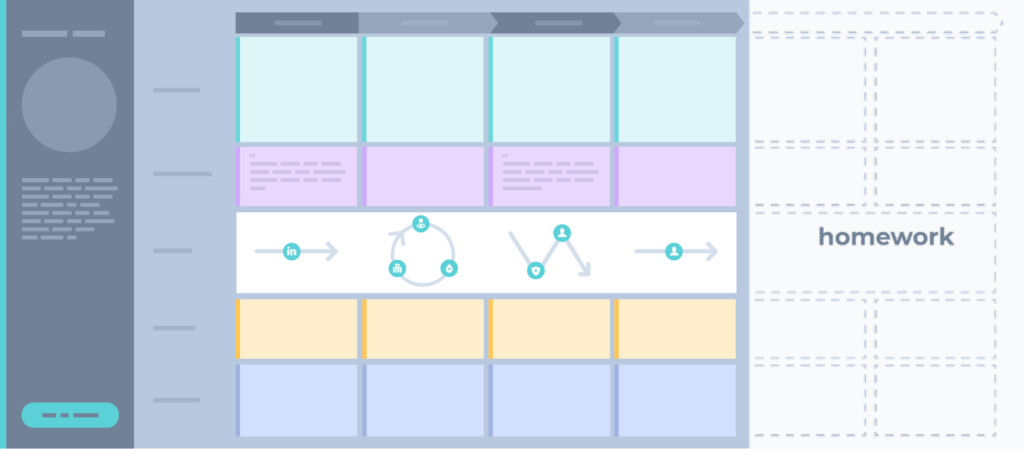
It’s also vital to prepare the ground. Give people a heads-up that it’s okay not to remember some things about the map after they get out of the workshop context. This way, collaborators won’t be so surprised that the map feels unfamiliar when they need to return to it after a while.
Think of organizing subteams to work on the map’s parts. It’s always easier to work on the smaller bits of the map than to ask everyone to work on the entire map. So split people into groups, give each group a part of the map to work on, and ask them to meet once they’re done to finish the map together. For 2-3 people, it’s much easier to meet up. Also, working together would make a whole difference as opposed to struggling alone on the entire map.
UXPressia tip #6: Hide unnecessary map parts
In UXPressia, you can create different Views of the same map to focus your teams’ attention only on the information they need.

There are two more things you can do:
- Set up an initiative chat or a channel for the team. Having a chat in some messenger or a separate channel in Slack or Discord could be a bright idea. People could discuss their progress, ask questions, or compare approaches in such a chat. To ease the tension and get the conversation going, throw in some conversation starters.

- Provide input for people who weren’t at the workshop. It’s one challenge to get back into the context when you were a part of the workshop, and it’s an entirely different one when you start diving into it from scratch. To make the process easier for your teammates, try making some sort of map overview or guidance through the map parts. In UXPressia, for example, you can use audio comments for this purpose.
Scenario 2: Building the entire map asynchronously
Mapping is a collaborative effort. So it is not the best-case scenario when you do it without enough space for conversation and exchange. But the reality is that sometimes the team starts building their map from scratch asynchronously for various reasons.
For example, you may not have enough time to do any kind of collaborative session: because the team is scattered across 5 different time zones and there is no suitable time slot for everyone to meet.
As for the common challenges of the fully asynchronous journey mapping exercise, they are:
- No consistency. People are different, they have their own writing and thinking styles, and as a result, the map’s content may be a bit hectic.
- Collaborators skip non-empty sections. There’s always that part of the map that is already filled out with different information and you’re left wondering: is it worth it to add even more findings here? Will they add any value?
- Or there can be the opposite situation when teams are shy to add points to empty sections. The fear of the blank page is real: it takes some courage to be the first one to bring up a finding or an idea.
- Someone didn’t do their part (and the tasks were assigned). This could happen, especially when the mapping team does it as an additional project and has a lot on their plate already. The most common reasons in our experience are the lack of time and being overstretched, the lack of belief in the initiative, or the lack of understanding of how to do it.
These challenges seem huge, don’t they? But don’t worry. We’ve got some tried-and-tested solutions for you.
Provide examples, hints and show the way
Give as specific tasks as possible and back them up with some examples.
UXPressia tip #7: Put examples and hints on the map
At UXPressia, we like to use the first column of the map for this purpose. We fill it in with framing questions and tips on how to fill out each section. This will be a great help for those who have the so-called "fear of the blank page." You can also pre-fill some parts to set an example, and others will follow.

Ask your team to do consistency checking
No matter how much you pre-plan the collaboration, there still will be some inconsistency in how your team fills in the map. What can you do about it? Accept that fact, as it's inevitable, and also plan a peer review.
For example, subteams work on halves of the map, then they swap and review the others’ part of the map, highlighting anything unclear or debatable.
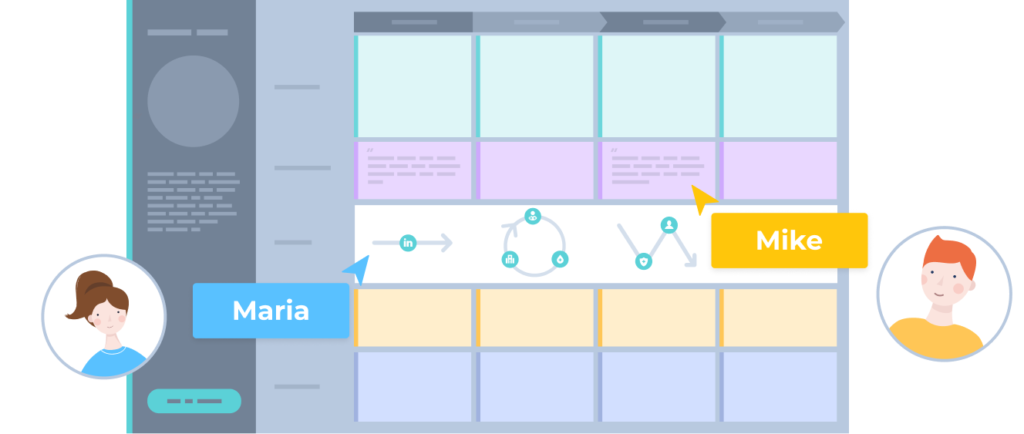
Make sure the participants have enough time
Collaboration might take some time, so communicate with team's supervisors to ensure that the team has proper time to contribute. This way, the supervisors will distribute tasks accordingly.
It also makes sense that everyone agrees that saying "I need more time" is fine. There might be two extremes here:
- Some people will work overtime to get things done.
- Others will let you know they didn't have enough time one hour before the deadline.
For that reason, agree beforehand that saying "I need more time" is okay and encourage doing that at least one day before the deadline.
Make yourself available for short meetings
If you are responsible for the initiative and have the capacity, it is a great help to offer people short 1-1 or small group conversations in case they have questions or are unsure how to proceed. It could take 15 to 30 minutes of your time to get people unstuck and assist them in moving forward.

Scenario 3: Validating and adding more data
When the team has already mapped everything at the workshop and now needs to validate some map parts and get additional data on something you are unsure about, asynchronous collaboration comes to the rescue. This approach is very common and many teams work async during this stage.
Here are the common challenges for this scenario:
- There is a difference in understanding what validating means. Every organization sets the rules their own way. For some, it is enough to have several signals about the problem mentioned in the client interview. For others, it is important to back every statement with quantitative data. And sometimes this step is crucial in getting teams’ trust in the entire initiative, not only the journey mapping exercise itself.
- There’s a lack of time and/or resources to properly back up everything you have on the map. When your team highlighted all the statements on the map that, in their opinion, require checking or additional research, you might have a list of 15 things. Then you can easily go ahead and check them all. But what if you have 100 notes?
- Validation requires sense-making, while sense-making usually requires some conversation, which is harder to do asynchronously.
- It’s not clear how to incorporate all sorts of data into one map.
- It’s unclear who is responsible for adding specific pieces of information.
Take advantage of the following pieces of advice to rise to these challenges:
Set up some rules
When you’re not on the same page about what validation is, things can become a mess real quick. Come up with a scale that works for your team. We like to use the following scale: “if this is repeated at least once, we take it” or “assumption - soft signal - strong signal”.

For example, your brand-new menu is hard to read. If someone on the team says it or if a customer mentioned it once, mark it down as an assumption. If there are several signals (let’s say 3), we call them soft signals. Those are very important, don’t dismiss them. And if more than 10 customers complain that your new menu is hard to read, count it as hard data.
It’s not always about quantitative proof, it is often about rules and conventions you set within the team. It's impossible to conduct a complete study about everything, so play around with the scale to fit your processes.
Prioritize (and encourage others to do so, too)
Also, everyone should get on the same page about the priorities. You can use questions like “Which statements significantly influence how we move forward?”
For example, if the problem with checking into the hotel is rather an exception, we can disregard it. But if it often happens, we should direct our attention there - let’s validate.
Discuss roles at the beginning of the initiative
Suppose you work in a team that already has clear roles, great. Just communicate these roles to everyone one more time.
If you work in a cross-functional team that was created for the project, it’s good to have a high-level understanding of the “jobs” to do and discuss whether research and validation, refining, and polishing of the map would be one person’s responsibility or split between the team members.
UXPressia tip #8: Set access permissions according to your needs
Some of your team members will need to contribute to the journey map, while others will only view the map and approve certain parts or give feedback. In UXPressia, you can share your project and distribute access permissions as you go.
UXPressia tip #9: Assign owners to each touchpoint
In addition to a to-do list and dedicated Views for subteams or even separate team members, you can do even more on the Touchpoint level by assigning owners to them. Owners are those individuals who are responsible for everything related to a touchpoint.
You may also like: Touchpoints and channels in customer journey mapping
They may not participate in the journey mapping exercise, but you will be able to reach them with touchpoint-specific questions and ideas. Alternatively, you can assign owners who will be responsible for adding more details to the touchpoint card or keeping track of its performance and updating it regularly.
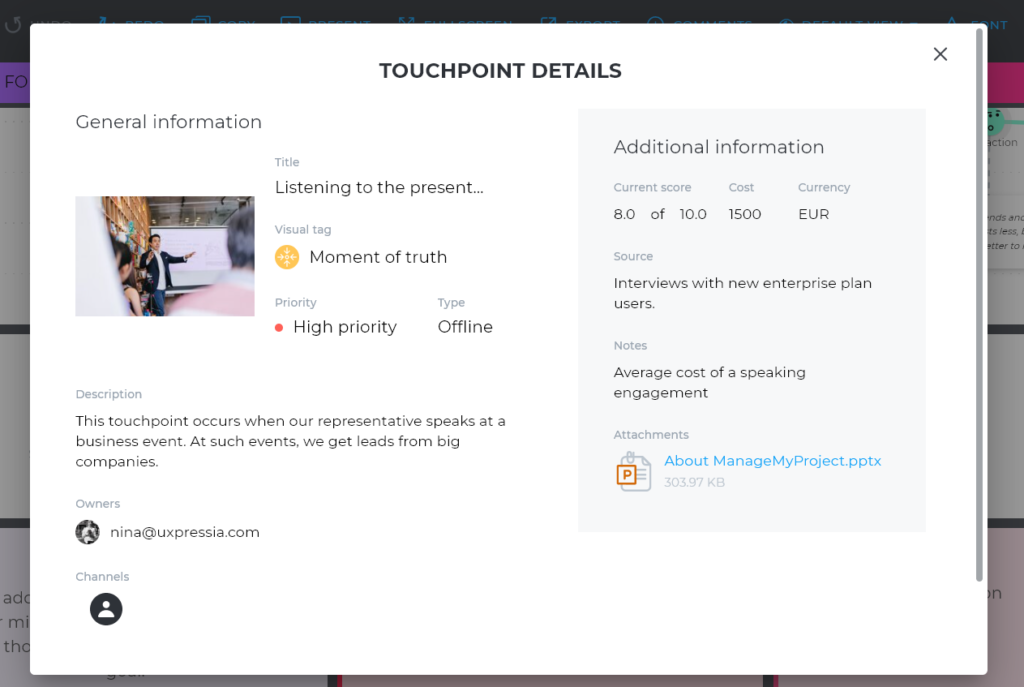
Get a second pilot
It’s a clever idea to involve a team member as a second pilot in the research. They don’t need to specialize in it but rather be a helping hand.
To sum it up
In this blog post, we talked about doing a journey mapping exercise collaboratively in an asynchronous mode. We looked at the three scenarios and covered common challenges for each of them. We also provided some guidance and UXPressia platform-related tips on how to eliminate them.
The recording
Do you prefer watching to reading? Check out the recording of our event devoted to asynchronous collaboration.
